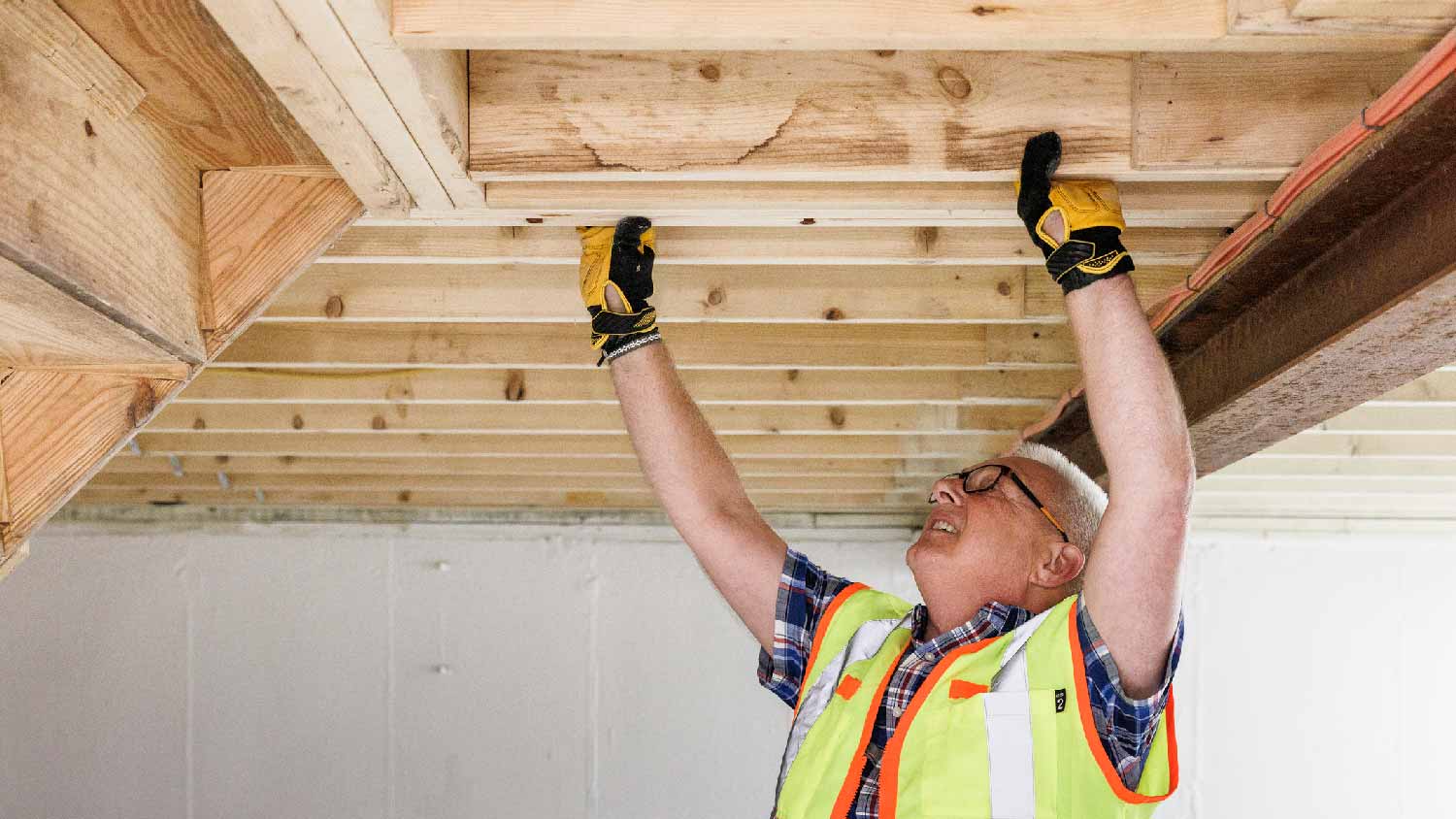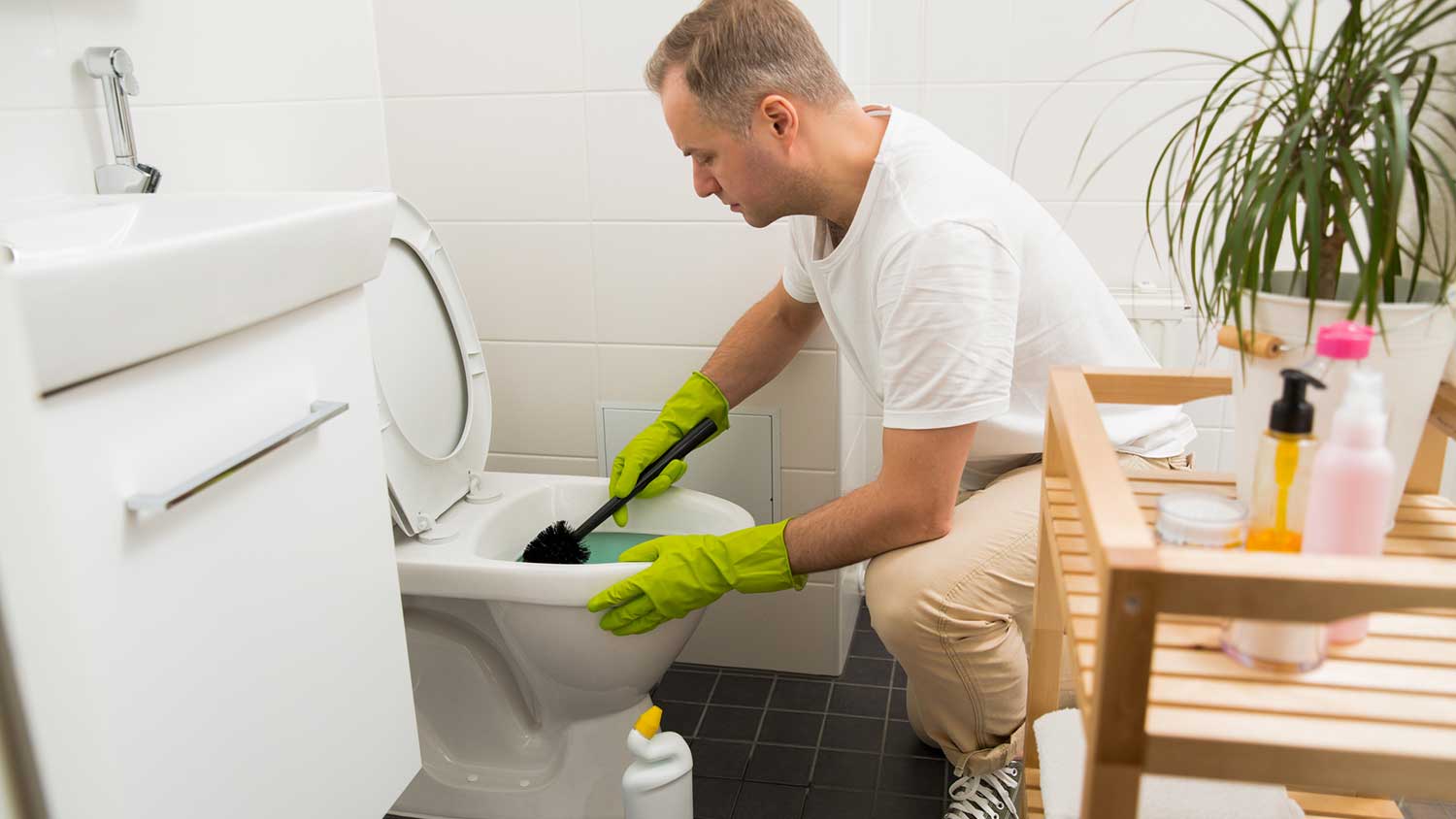How to Get Rid of Black Mold Safely and Completely
Take precautions to treat black mold, and stay safe


For some people, seeing certain items in their homes can be quite terrifying, like spiders or mice. You may panic and try to remove them as quickly as possible. If you see black mold, you may have the same feeling of fear. However, do not grab a cleaner and start scrubbing out of panic. Learning how to get rid of black mold the right way is the key to doing the job safely and effectively. Failing to take precautions, or refusing to call in the pros at the right time, could spell disaster with black mold.
Why Do I Have Black Mold in My Home?
Just like any kind of mold, black mold needs moisture and some sort of food to gain a foothold. If these conditions persist, the black mold can expand quickly, creating a nasty looking stain that also could make you sick through inhaling it or through a direct exposure.
Sometimes, the mold needs constant and direct moisture exposure to start growing. Other times, though, simply having significant humidity in a room can be enough to give black mold a foothold.
For the food it needs, black mold can make use of organic materials like paper or cardboard. That’s why it often forms on drywall, making use of the paper covering. It also can grow on porous materials, such as wood.
Black mold spores can sit dormant for years until conditions are just right for them to grow and expand.
How Much Does it Cost to Get Rid of Black Mold?
If you choose to hire a local black mold removal expert to get rid of the mold you are seeing, it can be pricey. The average mold remediation cost when hiring a pro is about $2,200, However, you could pay significantly less or more, depending on the size of the problem, and the ease with which the pro can access the area.
In some cases, it won’t be possible for the mold removal team to simply clean the area. You may also need to remove the items that had the black mold infestation, such as removing a large piece of drywall and patching it with a new piece. You may need to hire a local drywall repair company to perform this work for you. An average drywall repair cost is almost $600, but your cost could be much higher or lower, depending on the size of the job.
How to Identify Black Mold
Before you reach out to a professional who can help you figure out how to get rid of black mold, you may want to be certain you have black mold.
What does black mold look like? From a distance, black mold looks like a dark-colored stain on an object, like a wall, an exposed support post, a wood floor joist, or a cardboard box. To be certain you have black mold, you may want to inspect it up close. Characteristics of black mold include:
Black, dark brown, or dark green as a primary color
White or orange flecks as a secondary color
Individual circular markings that make up the overall stain
May have a slight fuzzy texture
May look slimy
May have an odor of dampness or rotting vegetables
Some types of mold, such as black mold, can be harmful to your health. If you suspect black mold is in your home, hiring a mold remediation pro is the only method to completely remove it.
Take Precautions to Work Around Black Mold Safely
You may have heard that black mold is especially dangerous for your health. Is black mold toxic? It can be, according to the Cleveland Clinic, but not always. If you have an unknown allergy to mold, for example, you could become extremely ill.
Regardless, it’s better to not expose yourself and take the chance of spreading black mold spores into your heating and cooling ducts. Let the pros handle this job.
Before moving close to inspect the stain to identify it as black mold, you should put on:
Goggles
A breathing mask or respirator
Gloves
Protective layers over clothing
Clothing that you can wash immediately
Identifying Black Mold vs. Similar Substances

Most homeowners—understandably—are not experts in mold identification. Rather than black mold, you may have a different kind of mold or a different kind of problem entirely.
When wondering if you have black mold versus regular mold, the color can help you decide. Black mold is always a dark color, while other mold can be light colored or dark colored. Additionally, black mold often is slimy or fuzzy, while other molds sometimes are not. Black mold almost always appears on walls, wood, or cardboard. Other types of mold can appear on food or bread, along with wood and cardboard.
You also may want to understand the differences between black mold versus wood rot. While both can appear on damp wood in a basement or crawl space, they react far differently. Black mold or other molds cause discoloration on wood, while wood rot actually causes damage to the wood. If you see wood rot on a support post or floor joist, seek help from a local general contractor.
Always wear protective gear before inspecting anything you believe could be black mold. If you are ever unsure about what you are seeing, reach out to a local mold inspector for some assurance before you decide how to proceed.
How to Eliminate Black Mold
The best way to eliminate black mold completely is to seek the help of a professional. It’s simply too risky for a novice to tackle.
Find the Moisture Source
You should try to locate where the moisture is coming from. Search for any signs of leaks, condensation, or other possible sources of water.
Test the Area for Moisture
Sometimes you can’t see moisture with a visual inspection. But you can test your home’s humidity levels using a hygrometer. Any reading higher than 50% humidity could be the moisture source feeding the black mold.
Don’t Scrape Black Mold
If you try to scrape black mold off a wall, you may simply release the spores into the air, potentially causing you to inhale them. Avoid touching it with any tool or with your hand.
Don’t Cut Through Moldy Drywall
If you have a large section of drywall that is showing signs of a black mold infestation, don’t run a saw or utility knife directly through the mold. Additionally, don’t cut the drywall if you suspect black mold is on the inside of the wall, as you will spread the spores.
Rather than cutting the drywall yourself, you should reach out to a mold removal pro for help. As a novice, you simply cannot do this process safely. Rely on the pro for the proper tools, protective gear, and experience level.
Watch for a Return of the Black Mold
After your local mold removal pro handles the black mold for you, watch the area for a few weeks. It’s not likely that it will grow back. However, if it does, spotting the issue early can help. Call the pro to return to treat it again.
How to Prevent Black Mold From Forming

Black mold needs moisture to begin growing. If you have a leaky pipe, a leaky toilet, or a leaky roof, the excess moisture from these leaks can lead to mold developing. Fix these items to eliminate the unwanted moisture.
Having high levels of humidity inside your home can encourage black mold growth, too. Try to keep humidity levels below 50% at all times in all areas of your house by using a dehumidifier.
In case of a flooded basement, take steps to try to dry the area as fast as possible. Discard any damp cardboard or stacks of paper that could serve as a home for black mold growth after a flood.
However, you should not do this preventative work if you already have black mold in the area. Call a pro for help.
DIY vs. Hiring a Pro
Learning how to get rid of black mold yourself is not a DIY job because of the potential dangers.
Pros offer a guarantee that they will do the job safely and correctly the first time. If you attempt to clean mold yourself, you may fail to remove all of the spores, meaning the mold could return in the future. You could also expose yourself and your family to severe illness.
Ultimately, figuring out how to remove black mold is a job where it’s best to seek the help of a professional.
Frequently Asked Questions
Inhaling black mold spores, even from behind walls, can cause people to have a wide variety of potential health issues. Some people may only notice a few breathing problems, while others can become quite sick with symptoms related to severe allergies. Constant exposure to mold spores can lead to lung infections and other long-term health problems. If you believe you have black mold inside your walls, you will want to reach out to a pro for an inspection and for advice on how to take care of the problem before it causes severe illness.
If you suspect black mold is inside your walls, do not punch a hole in the drywall yourself to look. Call a mold inspection expert to help you. Some signs of a potential black mold infestation inside the wall include an unexplained musty, damp smell. Some people liken it to rotting vegetables. You may smell it most strongly through a wall outlet. If you and your family are experiencing constant coughing or symptoms that feel like an unexplained allergy, it could indicate black mold behind a wall.
No, not all black mold is toxic. Although people often refer to stachybotrys chartarum as toxic black mold, there is little evidence that any one type of black mold has more toxicity than another. People who have an allergy to black mold would be more likely to have a dangerous reaction after inhaling it. Long-term exposure to black mold spores can lead to severe infection and disease. Some people only have minor health problems after black mold exposure. Ultimately, toxicity is rare with any kind of mold, but it is possible, so always take the appropriate precautions.





- What Does Black Mold Look Like?
- Black Mold in Your Air Ducts: Symptoms, Signs, and Prevention
- Is Black Mold Toxic? If So, How Can You Tell?
- How to Test for Mold in Your Home
- Green Mold vs. Black Mold: What’s the Difference?
- 12 Signs of Mold in Your House and What to Do About It
- How To Remove Mold From Wood Furniture in 30 Minutes
- How to Remove Mold From Fabric Furniture
- What Causes Mold in Your House?
- How to Prevent Mold Growth in Every Area of Your Home











